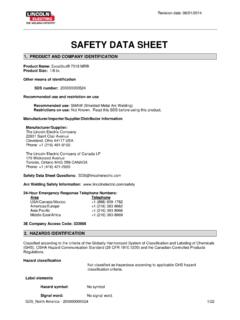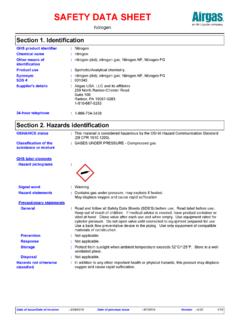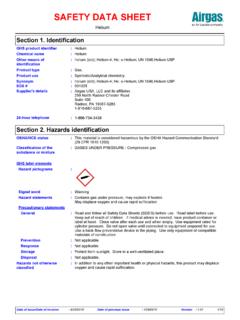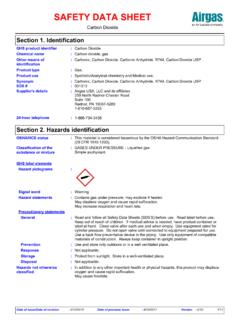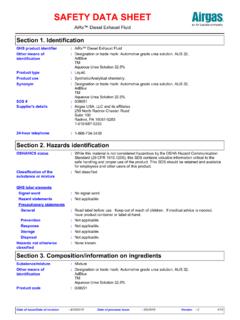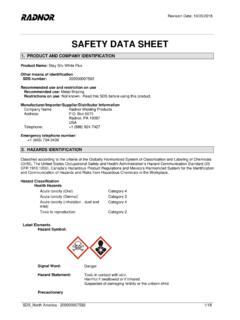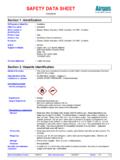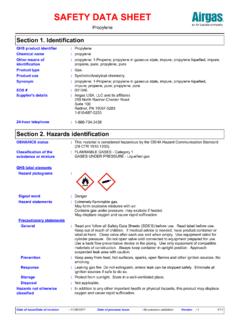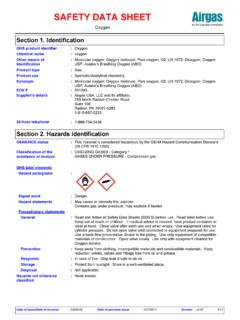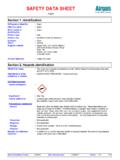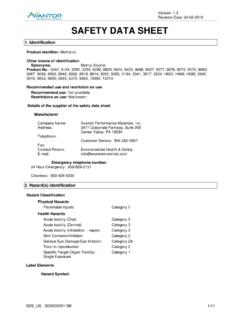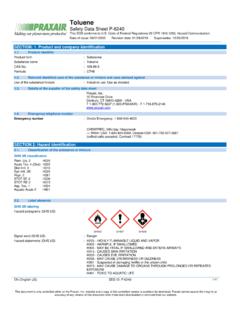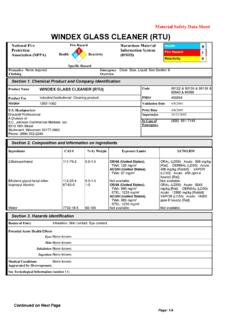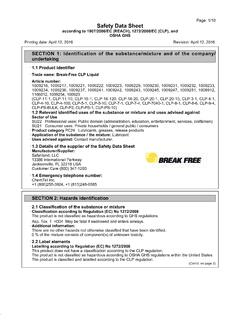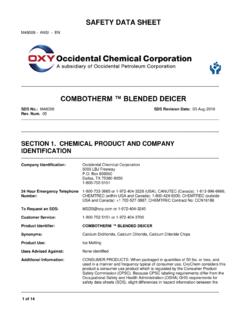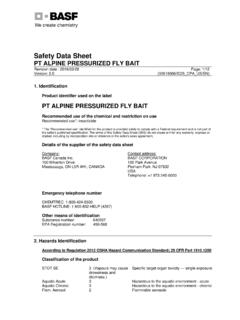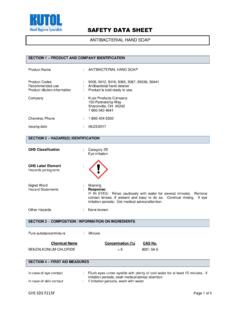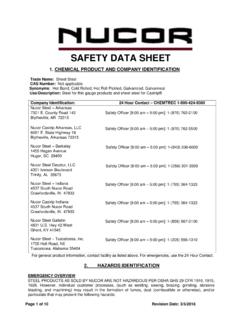Transcription of SAFETY DATA SHEET - Airgas
1 PropanePropyl hydride; n-Propane; Dimethyl methane; Bottled gas; propane in gaseous state;propane liquefied, n-Propane; Dimethylmethane; Freon 290; Liquefied petroleum gas;Lpg; Propylhydride; R 290; C3H8; UN 1075; UN 1978; A-108; Hydrocarbon gasSAFETY data SHEETGHS product identifierOther means of identificationProduct typeSection 1. Identification:::Chemical name:propaneSupplier's details:PropaneProduct use:Synthetic/Analytical :Propyl hydride; n-Propane; Dimethyl methane; Bottled gas; propane in gaseous state;propane liquefied, n-Propane; Dimethylmethane; Freon 290; Liquefied petroleum gas;Lpg; Propylhydride; R 290; C3H8; UN 1075; UN 1978; A-108; Hydrocarbon #:001045 Airgas USA, LLC and its affiliates259 North Radnor-Chester RoadSuite 100 Radnor, PA 19087-52831-610-687-52531-866-734-3438:2 4-hour telephoneSection 2.
2 Hazards identificationFLAMMABLE GASES - Category 1 GASES UNDER PRESSURE - Liquefied gasClassification of the substance or mixture:Signal word:DangerHazard statements:Extremely flammable gas under pressure; may explode if pictograms:Precautionary statementsPrevention:Keep away from heat, hot surfaces, sparks, open flames and other ignition sources. No :Leaking gas fire: Do not extinguish, unless leak can be stopped safely. In case of leakage, eliminate all ignition :Protect from sunlight. Store in a well-ventilated label elementsGeneral:OSHA/HCS status:This material is considered hazardous by the OSHA Hazard Communication Standard (29 CFR ).May cause displace oxygen and cause rapid form explosive mixtures with and follow all SAFETY data Sheets (SDS S) before use. Read label before out of reach of children.
3 If medical advice is needed, have product container or label at hand. Close valve after each use and when empty. Use equipment rated for cylinder pressure. Do not open valve until connected to equipment prepared for a back flow preventative device in the piping. Use only equipment of compatible materials of construction. Always keep container in upright position. Approach suspected leak area with of issue/Date of revision:11/15/2020 Date of previous issue:10/5/2020 2. Hazards identificationDisposal:Not not otherwise classified:Liquid can cause burns similar to 3. Composition/information on ingredientsPropane10074-98-6 Ingredient nameCAS number%There are no additional ingredients present which, within the current knowledge of the supplier and in the concentrations applicable, are classified as hazardous to health or the environment and hence require reporting in this name:propaneOther means of identification:Propyl hydride; n-Propane; Dimethyl methane; Bottled gas; propane in gaseous state;propane liquefied, n-Propane; Dimethylmethane; Freon 290; Liquefied petroleum gas;Lpg; Propylhydride; R 290; C3H8; UN 1075; UN 1978; A-108.
4 Hydrocarbon number:74-98-6 Substance/mixtureCAS number/other identifiers:Occupational exposure limits, if available, are listed in Section concentration shown as a range is to protect confidentiality or is due to batch code:001045 Remove victim to fresh air and keep at rest in a position comfortable for breathing. Get medical attention if adverse health effects persist or are severe. Ingestion of liquid can cause burns similar to frostbite. If frostbite occurs, get medical attention. Never give anything by mouth to an unconscious person. If unconscious, place in recovery position and get medical attention immediately. Maintain an open airway. Loosen tight clothing such as a collar, tie, belt or waistband. As this product rapidly becomes a gas when released, refer to the inhalation flush eyes with plenty of water, occasionally lifting the upper and lower eyelids.
5 Check for and remove any contact lenses. Continue to rinse for at least 10 minutes. Get medical attention if irritation contaminated skin with soap and water. Remove contaminated clothing and shoes. To avoid the risk of static discharges and gas ignition, soak contaminated clothing thoroughly with water before removing it. Get medical attention if symptoms occur. In case of contact with liquid, warm frozen tissues slowly with lukewarm water and get medical attention. Do not rub affected area. Wash clothing before shoes thoroughly before victim to fresh air and keep at rest in a position comfortable for breathing. If not breathing, if breathing is irregular or if respiratory arrest occurs, provide artificial respiration or oxygen by trained personnel. It may be dangerous to the person providing aid to give mouth-to-mouth resuscitation.
6 Get medical attention if adverse health effects persist or are severe. If unconscious, place in recovery position and get medical attention immediately. Maintain an open airway. Loosen tight clothing such as a collar,tie, belt or 4. First aid measuresEye contactSkin contactInhalationIngestion::::Descriptio n of necessary first aid measuresMost important symptoms/effects, acute and delayedInhalation:No known significant effects or critical contact:Dermal contact with rapidly evaporating liquid could result in freezing of the tissues or can cause burns similar to frostbite.:Eye contactPotential acute health effectsDate of issue/Date of revision:11/15/2020 Date of previous issue:10/5/2020 4. First aid measuresProtection of first-aiders:No action shall be taken involving any personal risk or without suitable training.
7 It may be dangerous to the person providing aid to give mouth-to-mouth to physician:Treat symptomatically. Contact poison treatment specialist immediately if large quantities have been ingested or treatments:No specific of liquid can cause burns similar to frostbite.:IngestionOver-exposure signs/symptomsSkin contactIngestionInhalationNo specific symptoms may include the following:, frostbiteAdverse symptoms may include the following:, frostbite:::Eye contact:Adverse symptoms may include the following:, frostbiteSee toxicological information (Section 11)Indication of immediate medical attention and special treatment needed, if necessaryFrostbite:Try to warm up the frozen tissues and seek medical 5. Fire-fighting measuresPromptly isolate the scene by removing all persons from the vicinity of the incident if there is a fire.
8 No action shall be taken involving any personal risk or without suitable training. Contact supplier immediately for specialist advice. Move containers from fire area if this can be done without risk. Use water spray to keep fire-exposed containers cool. If involved in fire, shut off flow immediately if it can be done without risk. If this is impossible, withdraw from area and allow fire to burn. Fight fire from protected location or maximum possible distance. Eliminate all ignition sources if safe to do thermal decomposition productsSpecific hazards arising from the chemicalDecomposition products may include the following materials:carbon dioxidecarbon monoxideContains gas under pressure. Extremely flammable gas. In a fire or if heated, a pressure increase will occur and the container may burst, with the risk of a subsequent explosion.
9 The vapor/gas is heavier than air and will spread along the ground. Gas may accumulate in low or confined areas or travel a considerable distance to a source of ignition and flash back, causing fire or should wear appropriate protective equipment and self-contained breathing apparatus (SCBA) with a full face-piece operated in positive pressure mode. For incidents involving large quantities, thermally insulated undergarments and thick textile or leather gloves should be protective equipment for fire-fightersUse an extinguishing agent suitable for the surrounding media:::None extinguishing media:Unsuitable extinguishing media:Special protective actions for fire-fighters:Section 6. Accidental release measuresPersonal precautions, protective equipment and emergency procedures:Accidental releases pose a serious fire or explosion hazard.
10 No action shall be taken involving any personal risk or without suitable training. Evacuate surrounding unnecessary and unprotected personnel from entering. Do not touch or walk through spilled material. Shut off all ignition sources. No flares, smoking or flames in hazard area. Avoid breathing gas. Provide adequate ventilation. Wear appropriate respirator when ventilation is inadequate. Put on appropriate personal protective non-emergency personnelDate of issue/Date of revision:11/15/2020 Date of previous issue:10/5/2020 6. Accidental release measuresEnvironmental precautionsImmediately contact emergency personnel. Stop leak if without risk. Use spark-proof tools and explosion-proof equipment. Note: see Section 1 for emergency contact information and Section 13 for waste disposal.
